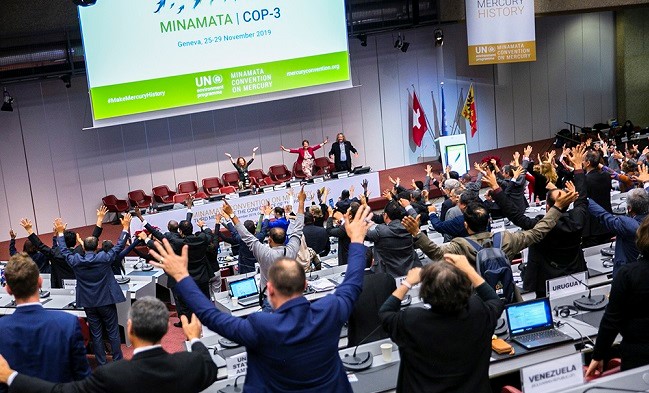By 2020, which is just days away, the manufacture, import and export of mercury-added products will no longer be allowed.

Parties to the Minamata Convention renewed their commitment to phasing out the use of products which contain mercury and to promote alternatives at the Third meeting of the Conference of the Parties (COP3) to the Convention that held from November 25 to 29, 2019 in Geneva, Switzerland.
Delegates representing 113 parties, including Nigeria, decided to undertake the review regarding the reduction on the use of mercury in manufactured products. Parties also agreed on how to use custom codes for mercury-added products that would permit to gather reliable information and therefore facilitate the control of trade in products containing mercury.
Indeed, batteries, switches, fluorescent lamps, cosmetics, pesticides, barometers and thermometers containing mercury have their days numbered. By 2020 the manufacture, import and export of these products is prohibited.
The good news, according to the promoters, is that a wide range of safe and high-functioning alternatives to mercury-containing products have been developed. Thus, they added, it’s just a matter of time before mercury-free alternatives fully replace their more toxic counterparts.
As it was emphasised during the opening session of the conference, the road map for effectiveness evaluation agreed at the second meeting of the Parties resulted now in a framework, which will help in defining how effective the Convention is by 2023.
“This COP has a key role to play in establishing the framework for the first evaluation of the effectiveness of the Convention, set for 2023. Strengthening legal frameworks and institutional capacity is also a basic requirement for the implementation of the Convention”, said Inger Andersen, the UN Environment Executive Director.
In the same line, the Executive Secretary of the Minamata Convention, Rossana Silva Repetto, admitted that “it is our common wish that the results of such evaluation reflect that our convention is proving to be effective. For this to happen, we need to work on the implementation of the convention at all levels in order to yield the fruits that indicate, in the data that will be collected, that we are on the right path towards attaining the objective that you, yourselves established for the Minamata Convention”.
Meanwhile, Parties have an obligation to submit their first national reports by December 2019 on the measures they have taken to implement a number of provisions of the Convention, on the effectiveness of such measures and on possible challenges in meeting the objectives of the Convention, as was agreed at the first meeting.
Other key decisions adopted at the Minamata COP3 include the programme of work and budget for the biennium 2020-2021, terms of reference for the Implementation and Compliance Committee, guidance on the management of contaminated sites, releases and waste thresholds. Parties reiterated their wish to continue to enhance cooperation with international organizations in areas of relevance to the Convention, towards the achievement of the 2030 Agenda for Sustainable Development Goals.
Donors announced voluntary contributions to the Specific International Programme to support capacity building and technical assistance, which is one of the components of the financial mechanism of the convention, the other one being the Global Environmental Facility (GEF).
COP3 has also been the opportunity for consolidating the substantial progress made so far at the previous COPs. At the first and second meetings, the COP took decisions that were key for the ongoing implementation of the Convention. Several guidance documents were adopted in relation to trade, best available techniques and best environmental practices in relation to emissions, and artisanal and small-scale gold mining (ASGM) National Action Plans (NAPs).
The events at the COP included a special session on mercury science highlighting the linkage between policy and science. Among the other 26 side events broader issues were discussed such as the linkages between chemicals management and biodiversity, artisanal and small-scale gold mining, trade, contaminated sites, chemicals and waste management beyond 2020, and global community’s efforts to protect human health and the environment from the negative effects of mercury.
Since the convention entered into force in 2017, meetings of the conferences of the Parties to the Minamata Convention on Mercury have been held during a one-week period every year in late September (COP1) or November (COP2 and COP3) at the seat of the Secretariat in Geneva, Switzerland.
From now, next COPs will be convened every two years. 2021 will be the turn of Indonesia to host the fourth Conference of the Parties to the Minamata Convention in Bali, to keep making mercury history.
